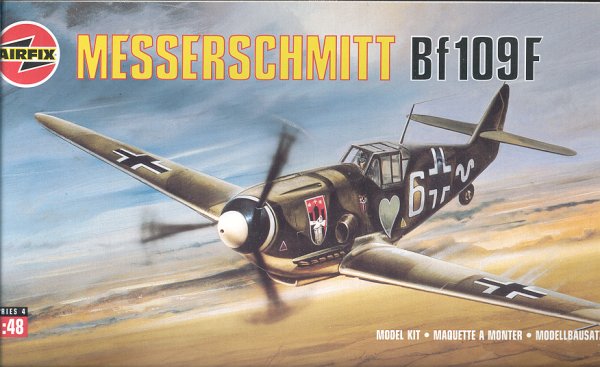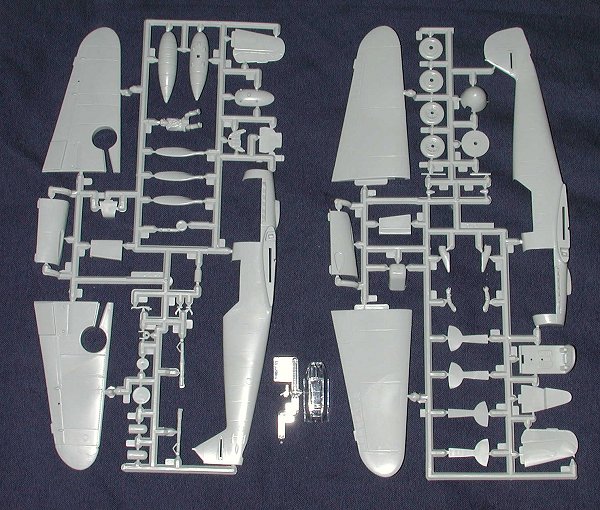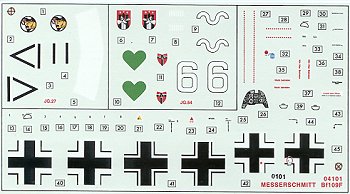
|
KIT: |
Airfix 1/48 Bf-109F |
|
KIT # |
4101 |
|
PRICE: |
@$15.00 |
|
DECALS: |
Two aircraft |
|
REVIEWER: |
|
|
NOTES: |
|

|
HISTORY |
Just to give a brief rundown. The Bf-109F was a real shocker to the British when it entered service. The improved airframe and updated engine gave a plane that was superior to the current fighters that the RAF was using. If the truth be known, this aircraft could have easily entered service a year earlier, however the Germans figured the war would be over in a short time so did not concern itself with bringing in upgraded designs and let it simmer until the need was seen.
Many Luftwaffe pilots who flew the various versions of the 109 state that the F model was probably the best of the lot. The biggest drawback was that there were no wing cannon as in the 109E versions. Though some of that was supplanted by the now standard engine mounted cannon, it still left the F model with less firepower. Having guns in the wings would have degraded the performance due to the extra weight and stresses on the wing, but would have made it a more potent adversary. Oddly, this was never fully rectified. Only by adding cannon in underwing gondolas were subsequent versions able to increase firepower.
|
THE KIT |

Airfix has often been maligned by modelers and that is a shame. Once you get away from the kits of the 50s and 60s, Airfix models are really quite nicely done. This particular kit comes from the early 1970s, a bit before the Revell 109G-10. The kit itself is well molded and an odd combination of raised and engraved panel lines. The wings have panel lines engraved, but the rest of the kit is raised. All of the detail work (hatches and covers) are raised, even on the wings. I won't vouch for dimensional accuracy as I just don't get into measuring kits. But it looks OK on the sprues.
My example suffers from some sink marks and ejector pin marks. Well, let me rephrase that. The fuselage suffers from sink marks and ejector pin marks. You see, the inside cockpit walls have really very nicely done detailing. It is better than what one gets with Hobbycraft in this respect. All of the various boxes and wheels are molded on the walls. This means rather thick plastic in there areas and the sink marks are on the outside opposite this area. There are also some near the tail wheel attachment. As for ejector pin marks, there are some in the wheel covers (which will be mostly covered by the landing gear) and right in the middle of the inside cockpit detail. These last ones will be difficult if not impossible to remove.
There is a complete interior with seat, stick, and instrument panel. The rudder pedals are molded on the forward wall. There is also a gun breech cover that is totally cylindrical. I don't think that is correct. The seat is also a bit too rounded for my taste and I don't think that is prototypical. There is some raised detail on the instrument panel and a decal is also offered. The head armor is glued to the back of the interior section vice the canopy as it should be. However, this won't be a problem as the canopy is a single piece and cannot be displayed open. The canopy itself is clear though a touch distorted. You should be able to see most of what work you put into the cockpit through it.
Turning to the rest of the kit, the wheels are in halves so that if you want to build your kit wheels up, it will be relatively easy to do so. There are separate gear doors just for this purpose and also a retracted tail wheel option. You can also see that the upper cowling is in two pieces. Not the easiest for construction, but perfect if you wanted to add engine detail.
Continuing on the outside, you have the option of a tropical filter. The
supercharger intake looks a trifle long and skinny to me, but it may be due to not having
built an F in so long. Another option is the drop tank and rack. The rack looks
too bulbous to me, but the tank appears OK. Those of us with large spare parts
bins will undoubtedly be digging through them to look for possible replacements
for some of these parts. What is missing to do a proper trop version are the two
small teardrop fairings on the left side near the cockpit for the umbrella. Not
missing are the four small tail braces that were added to most 109Fs after it
was found to have a weak join. However, they are rather indistinct and should be
replaced by very thin pieces of plastic strip.
Instructions are typical and what I call 'Euro-instructions'. That means all graphics and no write-up as you get with US and Asian kits. All color information is given in Humbrol paint colors. Fortunately, most of us anal Luftwaffe modelers know the proper colors! Two options are given; one for a JG 54 bird from Finland in what appears to be green and brown uppers with RLM 76 lower surfaces. The other is for a JG 27 aircraft from North Africa in RLM 79/80 with a midfuselage dividing line and white wing tips, spinner and rear fuselage band. The decal sheet is well printed and matte, though the white appears slightly off register. Naturally, no swastika. No worries as most of us have aftermarket replacements.
|
CONCLUSIONS |
I know that this isn't the latest and greatest. Airfix has been relying on old kits to keep it afloat. The short-sightedness of their accountants has prevented them from releasing any truly new kits, though they have been updating some of their older ones as witnessed by their current 1/48 Seafire kit. Regardless, this isn't that bad a model at all. With a modicum of work and some aftermarket/spare parts bin items, it can easily be brought up to near current standards. Besides, it is a LOT less expensive than the Hasegawa alternative.
Review kit courtesy of my kit collection.
If you would like your product reviewed fairly and quickly by a site that has well over 100,000 visitors a month, please contact me or see other details in the Note to Contributors.